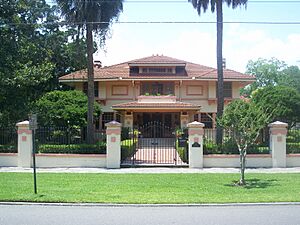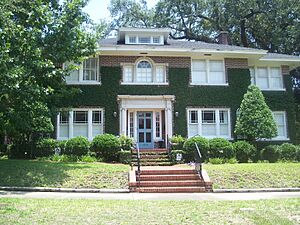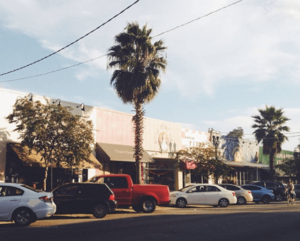Riverside and Avondale facts for kids
Quick facts for kids
Riverside and Avondale
|
|
|---|---|
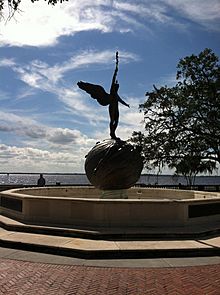
Sculpture by C. Adrian Pillars in Memorial Park
|
|
| ZIP Code |
32204, 32205
|
| Area code(s) | 904 |
Riverside and Avondale are two cool neighborhoods in Jacksonville, Florida. They are right next to each other. Many people even think of them as one big neighborhood! This area is mostly where people live. But it also has fun shopping and dining spots. These include Five Points, the King Street District, and the Shoppes of Avondale.
Riverside was first planned out in 1868. It became part of Jacksonville in 1887. The area grew a lot after the Great Fire of 1901. This growth continued until the Florida land boom ended in the 1920s. Avondale was created during this busy time, in 1920. Today, Riverside and Avondale are famous for their many different building styles. They also focus on keeping their history safe. This makes them Florida's most varied neighborhood for architecture. Both neighborhoods are listed as important National Register Historic Districts.
Contents
Exploring Riverside and Avondale's Location
Riverside and Avondale are located southwest of Downtown Jacksonville. They sit along the beautiful St. Johns River. The neighborhood has clear boundaries. Interstate 10 is to the north. The St. Johns River is to the east. Fishweir Creek is to the south. Roosevelt Boulevard and the CSX Railroad line are to the west.
It shares borders with other neighborhoods. These include Brooklyn and North Riverside to the north. Murray Hill is to the west. Lake Shore and Fairfax are to the south. The exact line between Riverside and Avondale can be tricky. Some say it's Seminole Road and Belvedere Avenue. Others, like author Wayne Wood, say it's around McDuff Avenue.
A Look Back: History of the Neighborhoods
How Riverside Began
Riverside and Avondale were built on land that used to be large farms called plantations. Most of this land came from two plantations. One was Dell's Bluff, given by the Spanish Florida government in 1801. The other was Magnolia Plantation, given in 1815. Both changed owners many times before the American Civil War.
In 1868, Miles Price, who owned Dell's Bluff, sold part of his land. He sold it to Edward M. Cheney and John Murray Forbes. They planned out the first Riverside area. Price developed the northern part himself. This became Jacksonville's Brooklyn neighborhood.
Riverside and Brooklyn grew slowly at first. But in 1887, Jacksonville took them over. A streetcar line was also added. After the Great Fire of 1901 destroyed much of Downtown Jacksonville, many people moved to Riverside. Rich families built big houses near the river. Others bought smaller bungalows further inland.
The neighborhood kept growing beyond its first borders. This continued until the Florida land boom ended in the late 1920s. Many architects worked in Riverside during this time. They tried out many different building styles. This made Riverside the most architecturally diverse neighborhood in Florida. Jacksonville likely has the most bungalow homes in the state, thanks to Riverside.
One special part of Riverside is Silvertown. It was a subdivision built in 1887 for African Americans. It was first separate from Riverside. But it later became part of the growing neighborhood. This meant Silvertown residents were some of the few Black homeowners in Riverside during segregation. Some old wood-frame houses there might be from the original development. One house was owned by a woman and her daughter from 1887 into the 1980s.
The neighborhood has also become a center for Jacksonville's LGBTQ community. It has many LGBTQ groups, places to gather, and events. The yearly River City Pride parade brings thousands of people to the Five Points area every October.
The Story of Avondale
Avondale was built later. It was a new part of Riverside on land from Magnolia Plantation. In 1884, some developers planned a community called "Edgewood" here. But it didn't take off. The land stayed mostly empty. Hunters even used it until the 1910s.
In 1920, a group of investors bought Edgewood and nearby land. They wanted to create a fancy, upscale neighborhood. They named it Avondale after a neighborhood in Cincinnati. It was called "Riverside's Residential Ideal." It was meant for "the right kind of people."
Avondale was a very planned community. It was different from the varied architecture in the rest of Riverside. Avondale mostly featured the Mediterranean Revival style. It was very successful. So, other nearby developments popped up. These eventually became part of Avondale too.
Keeping History Alive
The middle of the 20th century brought changes to Riverside and Avondale. Interstate 95 and the Fuller Warren Bridge were built. St. Vincent's Medical Center was established. New office buildings went up along Riverside Avenue. During this time, some historic buildings were torn down or left to decay.
People who loved the neighborhood fought back. They formed a group called Riverside Avondale Preservation in 1974. This group works to save historic buildings. They pushed for the creation of historic districts in the neighborhood.
Because of their efforts, the Riverside Historic District was added to the National Register of Historic Places in 1985. It was Jacksonville's first historic district. It now covers 6870 acres and has 2120 historic buildings. In 1989, the Avondale Historic District was added. The next year, the Jacksonville City Council created the Jacksonville Historic Preservation Commission. This group helps protect historic structures. Riverside Avondale Preservation has become one of the biggest groups like it in the country. Because of this focus on saving history, the American Planning Association named Riverside and Avondale one of the country's top ten neighborhoods in 2010.
Shopping and Fun: Commercial Areas
Riverside and Avondale are mostly places where people live. But they also have some cool shopping areas. These areas are designed to fit in with the neighborhood's style.
Five Points: A Unique Spot
Five Points is a small shopping area. It's named for the five-way intersection of Park, Lomax, and Margaret Streets. This area was once homes. But after World War I, it became a place for shops. Many retail buildings were built here. The Park Arcade Building was finished in 1928. It has an Italian Renaissance revival style. Its unique rooflines set the look for the whole area.
Another cool spot is Sun-Ray Cinema. It used to be Riverside Theater. It opened in 1927. It was the first movie theater in Florida to show talking pictures. For many years, Five Points has been known for its artistic and independent vibe. It has many unique shops, restaurants, and businesses.
King Street District: A Lively Hub
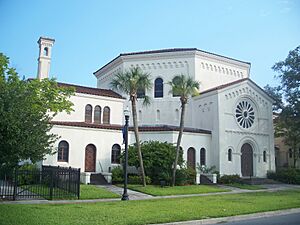
The King Street District started with Whiteway Corner. This was a group of shops at King and Park Street. The Nasrallah brothers built them starting in 1927. Their buildings had a row of street lights, which is why it was called "White Way". Other important buildings here include a 1942 Style Moderne building. It was built for Lane Drug Company. There's also the 1925 Riverside Church at Park and King Sanctuary. Famous architect Addison Mizner designed it.
Later, more shops and businesses spread along King Street. After some years of decline, King Street has become lively again since 2005. This happened after a successful project to improve the street. A popular beer bar opened that year. It set the trend for other places, many of them focused on craft beer. Now, the district has many bars, restaurants, stores, and night clubs. It also has an arts district and two craft breweries to the north. Because of all this growth, the King Street District became Jacksonville's main beer spot in the 2010s.
The Shoppes of Avondale: Boutique Fun
The Shoppes of Avondale has many unique shops, restaurants, art galleries, and bars. They are centered around St. Johns Avenue and Ingleside Avenue. Like Five Points, this area started in the 1920s when Avondale was first built. Its small buildings were made to fit in with the homes around them. The most notable building is from 1927. It was designed by Henry J. Klutho with Fred S. Cates and Albert N. Cole. The center was updated in 2010. This was part of a program to help neighborhood shopping areas.
Cool Places to Visit
Riverside and Avondale have several city parks. These include Riverside Park and Memorial Park. Memorial Park is right on the river. It has a statue called the "winged figure of youth" by C. Adrian Pillars.
The Cummer Museum of Art and Gardens is in Riverside. It opened in 1961. It has one of the world's best collections of Meissen porcelain. It also has large collections of American, European, and Japanese art. Plus, it has two acres of beautiful Italian and English gardens. These gardens are listed on the National Register of Historic Places.
The neighborhood is also home to Riverside High School. It used to be called Robert E. Lee High School. It's one of the city's oldest schools still in use. The Kent Campus of Florida State College at Jacksonville is also here. It's the oldest campus of that college.



